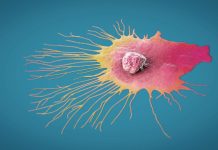
Research led by the University of Texas at El Paso and Bodoland University in India shows a special type of quantum dot made from caffeic acid, which can be extracted from coffee grounds, could be very effective at preventing the onset of neurodegeneration.
The research is still at an early stage, but showed promising results in the lab and the team thinks their technology could be particularly effective at targeting neurodegeneration caused by exposure to neurotoxic chemicals such as pesticides.
Neurodegenerative diseases such as Alzheimer’s disease, Parkinson’s disease, and dementia cost the U.S. economy billions of dollars a year in healthcare costs and are estimated to impact 50 million people a year. The causes of these conditions are multifactorial, but there is evidence to show that exposure to certain chemicals in the environment, such as some pesticides and herbicides, can significantly increase risk for developing conditions such as Parkinson’s disease.
“To date, there remains a gap in the satisfactory resolution of neurodegenerative disorders with no cure. A key challenge resides in the inability of candidate molecules that have succeeded in experimental and preclinical trials to cross the blood–brain barrier,” write co-lead author Mahesh Narayan, a professor at the University of Texas at El Paso, and colleagues in the journal Environmental Research.
“As a result, even though several potential drugs have been forwarded for treating neurodegenerative and neurological disorders, less than 1% cross the blood–brain barrier. To complicate matters, the blood–brain barrier hinders the entry of externally injected molecules from the systemic circulation, a crucial step in drug delivery. Access to therapeutics is also restricted by membrane transporters requiring a large treatment dose, resulting in side effects.”
Quantum dots are tiny (a few nanometers across) semiconductor particles that possess special mechanical properties that differ according to the particle size. To date, it has been difficult to use quantum dots inside living organisms, but this is largely due to most such particles being composed of heavy metals, which are toxic.
Caffeic acid is a small molecule, able to pass through the blood–brain barrier, which has antioxidant properties. Narayan and colleagues created quantum dots based on caffeic acid, rather than heavy metals, to try and stop neurodegeneration before it starts. The dots they created are designed to scavenge free radicals and stop them from causing neurological damage.
The researchers tested the dots in a human neuroblastoma-derived cell line and showed that they were able to protect the cells against oxidative stress-induced neuronal injury caused by exposure to the toxic chemical paraquat, one of the most commonly used herbicides around the world and a known causative agent for Parkinson’s disease.
Notably, the team also monitored the cells for cytotoxicity and the quantum dots were well tolerated with negligible side effects up to a concentration of 5 mg/ml.
“Caffeic-acid based Carbon Quantum Dots have the potential to be transformative in the treatment of neurodegenerative disorders,” said first author Jyotish Kumar, a PhD student in Narayan’s lab, in a press statement.
“This is because none of the current treatments resolve the diseases; they only help manage the symptoms. Our aim is to find a cure by addressing the atomic and molecular underpinnings that drive these conditions.”
The team are now planning to do more research to validate and expand on their findings and hopefully start the journey towards developing a preventative medication for neurodegenerative diseases such as Parkinson’s using quantum dot technology.













